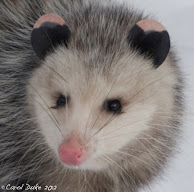I have been focusing on some of the trees and shrubs in my gardens that are like 'living bird feeders.' Countless perennials offer seeds and berries for birds as well. I am only mentioning a few that grow here in my gardens and wildlife habitat.
Soft scattered yellow blooms of Solidago, commonly known as goldenrod, dance in the afternoon light, along the north field. Monarch Butterflies are often seen flitting from one plant to another, sipping Solidago nectar, during late summer and into cooler autumn days.
Later, as the flowers fade, a female Common Yellowthroat may not be enjoying the plentiful seeds of goldenrod, but more likely the many insects attracted to the flowers. Goldfinches most certainly are big fans of the seeds. Please do not blame goldenrod for the pain ragweed causes.
If we leave our plants standing after they have flowered, birds will have many seeds during the fall and winter months.
A tiny caterpillar becomes a morsel of food.
Wild native perennials grow harmoniously here at Flower Hill Farm, right along with other more ornamental plantings. I love the wild touch and the benefits are great for wildlife. I have featured American pokeweed, Pokeberry, Phytolaccaceae and Solidago before, in a Wildflower Wednesday Post . Today I add these valued native perennials to my 'Living Bird Feeder' series. Pokeberry is poisonous, however, so allow to grow with caution. Robins and Cedar Waxwings go wild for the ripe berries. I often see the dark purple droppings about the garden in late summer, as proof to the bird's delight in dining on the fruit.
The dark purple-black berries are alluring and will disappear very quickly. Both the shinny berries and the roots are poisonous. Native Americans may have gathered the leafy shoots, before the pink developed, and cooked the greens for food.
Native Aralia Racemosa, American Spiknard, is of the Ginseng family and a remarkable perennial. Sprouting fresh each spring, it's expansive foliage spreads out fully . . . even in the shade . . . shooting up to a shrub-like plant by early summer. Spiknard then begins to create a bounty of berries that birds love. A very handsome and giving plant.
The Aralia Racemosa berries are a favorite of the Catbirds. I would like to transplant some, to make cluster plantings around my shrubberies. I believe they are hidden out in the front shade garden . . . only the clever and cunning Catbirds have discovered them in over a decade.
This post concludes my 'Living Bird Feeder' series. I have only touched on a tiny fraction of what we can grow, to support our wild feathered friends. Whenever I add a plant, shrub or tree to the gardens now, I consider their value as bird food and for that matter, nourishment for butterflies and bees too.
I want to share what my world is like today. I have set up a winter feeding station . . . inspired by the Bluebirds coming for my flies. The Bluebirds did find the water, but I have not seen them at the mealy worm feeder yet. Chickadees have discovered them!
A Tufted Titmouse has too!
Meanwhile the Cedar-Waxwings are barely making a dent into the abundant Crabapple crop.
'Old Man Bob' is not the only one up to his neck in snow! Is it a fantastic or fanciful musing to imagine he might be tired of it?! Thought those of you working in your gardens now might like to see what the landscape is like here in New England.
It is Blooming Friday over at Katarina's Swedish blog Roses and Stuff.
This weekend is the Great Backyard Bird Count. I will be sharing some of my favorite bird portraits, taken throughout the seasons, in the upcoming posts. A Parade of Flower Hill Farm's Avifauna. In the meantime, enjoy counting your backyard birds!






































































.jpg)


































































